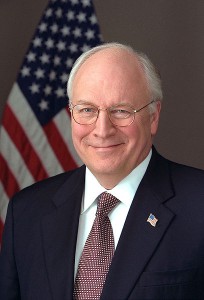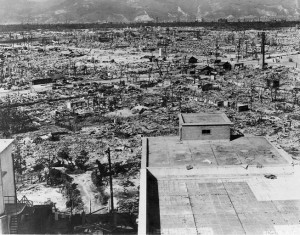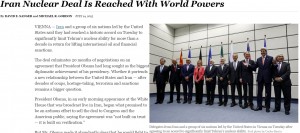Last week, Steven Aftergood released a January 27, 2003 OLC memo, signed by John Yoo, ruling that the Executive Branch could withhold WMD information from Congress even though 22 USC § 3282 requires the Executive to brief the Foreign Relations committees on such information. I had first noted the existence of the memo in this post (though I guessed wrong as to when it was written).
The memo is, even by Yoo’s standards, inadequate and poorly argued. As Aftergood notes, Yoo relies on a Bill Clinton signing statement that doesn’t say what he says it says. And he treats briefing Congress as equivalent to public disclosure.
Critically, a key part of the Yoo’s argument relies on an OLC memo the Reagan Administration used to excuse its failure to tell Congress that it was selling arms to Iran.
Fourth, despite Congress’s extensive powers under the Constitution, Its authorities to legislative and appropriate cannot constitutionally be exercised in a manner that would usurp the President’s authority over foreign affairs and national security. In our 1986 opinion, we reasoned that this principle had three important corollaries: a) Congress cannot directly review the President’s foreign policy decisions; b) Congress cannot condition an appropriation to require the President to relinquish his discretion in foreign affairs; and c) any statute that touches on the President’s foreign affairs power must be interpreted, so as to avoid constitutional questions, to leave the President as much discretion as possible. 10 Op. O.L.C. at 169-70.
That’s one of the things — a pretty central thing — Yoo relies on to say that, in spite of whatever law Congress passes, the Executive still doesn’t have to share matters relating to WMD proliferation if it doesn’t want to.
Thus far, I don’t think anyone has understood the delicious (if inexcusable) irony of the memo — or the likely reasons why the Obama Administration has deviated from its normal secrecy in releasing the memo now.
This memo authorized the Executive to withhold WMD information in Bush’s 2003 State of the Union address
First, consider the timing. I noted above I was wrong about the timing — I speculated the memo would have been written as part of the Bush Administration’s tweaks of Executive Orders governing classification updated in March 2003.
Boy how wrong was I. Boy how inadequately cynical was I.
Nope. The memo — 7 shoddily written pages — was dated January 27, 2003.The day the White House sent a review copy of the State of the Union to CIA, which somehow didn’t get closely vetted. The day before Bush would go before Congress and deliver his constitutionally mandated State of the Union message. The day before Bush would lay out the case for the Iraq War to Congress — relying on certain claims about WMD — including 16 famous words that turned out to be a lie.
The British government has learned that Saddam Hussein recently sought significant quantities of uranium from Africa.
This memo was written during the drafting of the 2003 State of the Union to pre-approve not sharing WMD information known by the Executive Branch with Congress even in spite of laws requiring the Executive share that information.
Now, we don’t know — because Alberto Gonzales apparently didn’t tell Yoo — what thing he was getting pre-authorization not to tell Congress about. Here’s what the memo says:
It has been obtained through sensitive intelligence sources and methods and concerns proliferation activities that, depending upon information not yet available, may be attributable to one or more foreign nations. Due to your judgment of the extreme sensitivity of the information and the means by which it was obtained, you have not informed us about the nature of the information, what nation is involved, or what activities are implicated. We understand, however, that the information is of the utmost sensitivity and that it directly affects the national security and foreign policy interests of the United States. You have also told us that the unauthorized disclosure of the information could directly injure the national security, compromise intelligence sources and methods, and potentially frustrate sensitive U.S. diplomatic, military, and intelligence activities.
Something about WMD that another nation told us that is too sensitive to share with Congress — like maybe the Brits didn’t buy the Niger forgery documents anymore?
In any case, we do know from the SSCI Report on Iraq Intelligence that an INR analyst had already determined the Niger document was a forgery.
On January 13, 2003, the INR Iraq nuclear analyst sent an e-mail to several IC analysts outlining his reasoning why, “the uranium purchase agreement probably is a hoax.” He indicated that one of the documents that purported to be an agreement for a joint military campaign, including both Iraq and Iran, was so ridiculous that it was “clearly a forgery.” Because this document had the same alleged stamps for the Nigerien Embassy in Rome as the uranium documents, the analyst concluded “that the uranium purchase agreement probably is a forgery.” When the CIA analyst received the e-mail, he realized that WINP AC did not have copies of the documents and requested copies from INR. CIA received copies of the foreign language documents on January 16, 2003.
Who knows? Maybe the thing Bush wanted to hide from Congress, the day before his discredited 2003 State of the Union, didn’t even have to do with Iraq. But we know there has been good reason to question whether Bush’s aides deliberately misinformed Congress in that address, and now we know John Yoo pre-approved doing so.
This memo means Obama doesn’t have to share anything about the Iran deal it doesn’t want to
Here’s the ironic part — and one I only approve of for the irony involved, not for the underlying expansive interpretation of Executive authority.
By releasing this memo just a week before the Iran deal debate heats up, the Obama Administration has given public (and Congressional, to the extent they’re paying attention) notice that it doesn’t believe it has to inform Congress of anything having to do with WMD it deems too sensitive. John Yoo says so. Reagan’s OLC said so, in large part to ensure that no one would go to prison for disobeying Congressional notice requirements pertaining to Iran-Contra.
If you think that’s wrong, you have to argue the Bush Administration improperly politicized intelligence behind the Iraq War. You have to agree that the heroes of Iran-Contra — people like John Poindexter, who signed onto a letter opposing the Iran deal — should be rotting in prison. That is, the opponents of the Iran deal — most of whom supported both the Iraq War and Iran-Contra — have to argue Republican Presidents acted illegally in those past actions.
Me? I do argue Bush improperly withheld information from Congress leading up to the Iraq War. I agree that Poindexter and others should have gone to prison in Iran-Contra.
I also agree that Obama should be forthcoming about whatever his Administration knows about the terms of the Iran deal, even while I believe the deal will prevent war (and not passing the deal will basically irretrievably fuck the US with the international community).
A key thing that will be debated extensively in coming days — largely because the AP, relying on an echo chamber of sources that has proven wrong in the past, published an underreported article on it — is whether the inspection of Parchin is adequate. Maybe that echo chamber is correct, and the inspection is inadequate. More importantly, maybe it is the case that people within the Administration — in spite of IAEA claims that it has treated that deal with the same confidentiality it gives to other inspection protocols made with inspected nations — know the content of the Parchin side agreement. Maybe the Administration knows about it, and believes it to be perfectly adequate, because it was spying on the IAEA, like it long has, but doesn’t want the fact that it was spying on IAEA to leak out. Maybe the Administration knows about the Parchin deal but has other reasons not to worry about what Iran was allegedly (largely alleged by AP’s sources on this current story) doing at Parchin.
The point is, whether you’re pro-Iran deal or anti-Iran deal, whether you’re worried about the Parchin side agreement or not, John Yoo gave Barack Obama permission to withhold it from Congress, in part because Reagan’s OLC head gave him permission to withhold Iran-Contra details from Congress.
I believe this document Yoo wrote to help Bush get us into the Iraq War may help Obama stay out of an Iran war.







